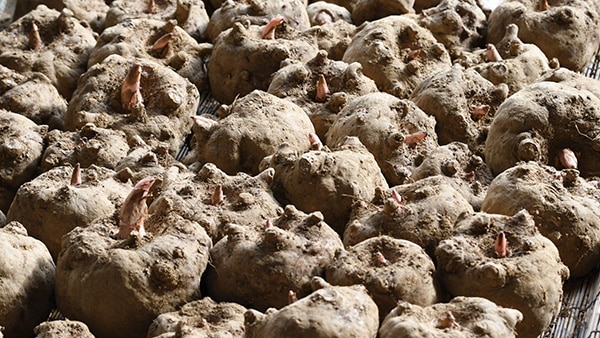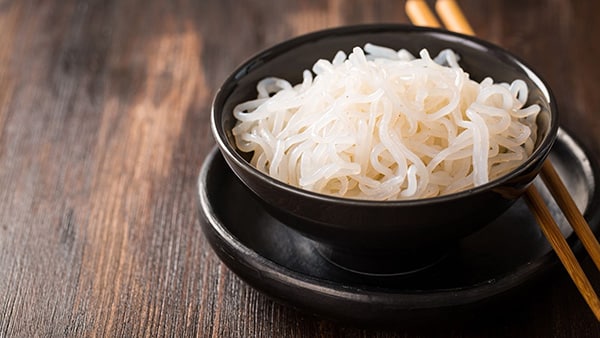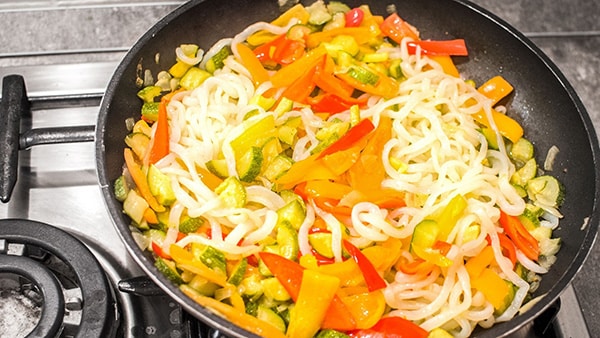A fashionable food in many diets, the konjac is still unknown to the general public. Native to Asia, this low-calorie and satiating plant can help you to lose weight. But is it a miracle slimming product to eliminate your few extra pounds? This is what we will discover in this article.
What is Konjac?
Konjac, an unknown Asian plant
Konjac is a food produced in AsiaThe company's main markets are Indonesia, Vietnam, South Korea, China and Japan.
This tropical plant of the Araceae family (or Araceae) grows in the forest and can reach a weight of 4 kg. It is also known as konnyaku or devil's tongue.
Konjac has been used for several hundred years in medicine Asian. It is, in fact, known for its multiple health benefits and is used, for example, to soothe coughs or burns.
In addition, it could prevent diabetes and cancer.
In what form can konjac be consumed?
Konjac is consumed for its root. The latter is particularly high-fiberparticularly in glucomannan. We will come back to this.
It also has a high content of vitamin B6.
Konjac is generally translucent or white in color and has no particular taste.
For centuries, Konjac has been used in Asia as a powder. It is enough to dilute it in a large glass of water to drink it and thus benefit from its virtues.
But it is also possible to find rice or konjac noodles. Known as Shiratakis in Japan, they can then replace your usual pasta in your diet.
Moreover, konjac is proposed in jelly to be added to certain culinary preparations, in order to thicken them (sauces, ganaches, cream desserts, etc.).
In capsules, the konjac is consumed as food supplements. Taken before meals, it quickly brings a appetite suppressant effect. However, be sure to respect the dosage and do not hesitate to consult a doctor to supervise the intake of konjac capsules. In any case, this consumption of konjac-based capsules must be punctual and of short duration.
Nutritional benefits of konjac
In recent years, konjac has become part of the dietary habits of many people in overweight and want to slim down.
This is simply explained. Konjac is known to reduce the feeling of hungerwhile offering an insignificant caloric intake.
For 100 g of konjac, count less than 10 calories. We are far from the 100 to 150 calories provided by 100 g of pasta!
Konjac and weight loss
The benefits of konjac are varied.
It is not by chance that nutritionists recommend eating konjac regularly. Konjac is, for example, one of the flagship foods of the Dukan diet.
In addition to its low calorie intake, it has an appetite suppressant effect ideal for losing weight. This food calms the appetite and offers a real feeling of satiety.
This satiating power is made possible by the high fiber content of konjac. The glucomannanA fiber extracted from the tuber, has the amazing ability to expand and line the walls of the stomach. It can thus absorb up to 100 times its own weight in water.
Within the framework of a dry, the konjac is thus a good means to set up and hold a caloric deficit. As all body-building enthusiasts know, a simple snack can jeopardize the success of a low-calorie diet.
By providing a sense of satiety, konjac can help you reduce temptation and reach your goal of weight loss. If you have trouble controlling your eating, eating this food may be a good idea.
In addition to that, this plant participates in the decrease of the bad cholesterol. In addition, it fights against stomach aches and constipation.
In summary, Konjac and diet are a good match. However, this food must be consumed with moderation. It should not become the main food in your diet.
What are the disadvantages of konjac?
At first glance, a konjac-based diet might seem to be very effective to slim down.
But on closer inspection, it's a little more complicated. Basing your plan on the dryer on konjac is not a good idea.
If you eat konjac at every meal, you will most likely suffer from deficiencies. Indeed, because of its appetite suppressant effect, this plant will limit your consumption of other foods that your body needs to function properly.
These vitamin, nutrient and mineral deficiencies can have negative consequences on your health. As always, the abuse of a food is not recommended. Consuming konjac almost exclusively will not allow you to lose fat in the long term.
To express all its benefits, konjac must be incorporated sparingly into a healthy eating and balanced.
In addition to these deficiencies, eating too much konjac can also cause bloating or digestive problems. It is strongly advised against people who suffer from a blockage of the digestive tract.
If you want to lose weight over the long term without hurting your body, it is best to opt for a physical activity such as weight training and the implementation of a balanced diet.
It is by taking good eating habits that you will be able to reach your goals. Consumed in small doses, at a rate of 2 or 3 times a week, konjac can then be an ally of your weight loss.
On the other hand, this 0 calorie food will not be of any use to you for your weight gain muscle. To gain weight, it is essential to put on a caloric surplus. The satiating aspect of konjac will not allow you to eat enough to gain muscle.
How to cook konjac?
Consumed plain, konjac has no real taste. Eating tasteless food too often can de-motivate you and make you want to stop eating.
If you want to incorporate it into your meal plan, you will need to learn how to cooking with konjac. Several options are available to you.
The konjac soup is without a doubt one of the most popular recipes. It can be prepared 1,000 and 1 ways. Personally, I usually make it in broth, with chicken or turkey, green beans and mushrooms. Discover this preparation in my book of healthy and greedy recipes for sportsmen.

DISCOVER MY E-BOOK OF RECIPES
You can also prepare konjac as you would your regular pasta. Garnish your dish with meat (chicken, turkey or low-fat beef), tomato paste, onion and spices for a light and healthy version of traditional spaghetti bolognese.
Konjac also goes very well with salmon, as well as some seasonal vegetables. In short, the possibilities are endless to enhance the taste of this healthy food and low in calories!
There are a multitude of Konjac recipes that are both quick and easy to prepare. It's up to you to find the ones that suit you best.
Where to buy konjac?
It is nowadays quite easy to find konjac in the shops. This was not the case for a long time.
On the Internet, I recommend konjac from Prozis. Available as noodles or rice, it is of excellent quality. Low in calories, this konjac is ideal to keep your diet and not exceed your calorie quota on a daily basis.
You can also buy konjac in most large food stores. It is generally found in the organic section or in the section dedicated to Asian cuisine. Depending on the store, you will be able to buy it in its different forms.
Conclusion
Native to Asia, konjac is a low-calorie plant that has a place on your menu in dry period. On the other hand, it has no interest in gaining mass. However, be careful not to consume too much of it, even when you are trying to lose weight. Rich in fiber, this food has the particularity to swell in the stomach and to cut hunger. This can of course cause dangerous deficiencies for your body. Basically, the taste of konjac is not very good. Fortunately, you can spice it up by cooking it in broth or with meat and some fresh vegetables.










